

Russia had to become the pariah, if there was any hope of weaning Europe away from Moscow’s oil teat. India took advantage of global low crude oil price in April & May 2020, Ministry took rapid action in filling these reserves completely, leading to a saving of INR 5000 crore for the Government. The kingdom turns to oil to meet power needs, which typically peak as demand for cooling rises with summer temperatures.

The country’s rich endowment of natural assets — not all of them hydrocarbon-based — could fuel new industries and sustain existing ones as carbon emissions fall toward zero. Its reserves of phosphates, copper and gold are world-class, but have been under-exploited thanks to the way crude crowds out everything else. The kingdom’s solar potential, meanwhile, is among the richest in the world, giving Saudi Arabia the chance to be as central to a future green-hydrogen sector as it was to the past century’s petroleum trade. In Spain, one of the countries hit worst by the disease, oil product demand fell by 23% in March, according to BloombergNEF.
Share this Comment:
After nearly five years of efforts to diversify the economy away from crude, oil and government spending largely funded from petroleum still account for about Saudi Arabia’s two-thirds of gross domestic product. It has significant proven reserves of 5 percent of the world total—and is the world’s leading petroleum producer. Canada, United States, Latin America, Africa, and the region occupied by the former Soviet Union contains less than 15 percent of the world’s proven reserves. Economic reforms already underway in some countries need to accelerate, he said.
The nation will likely continue to add oil to its strategic reserves in 2020, but is running out of space and can probably only sustain daily additions of 300,000 barrels for the rest of the year. On Thursday, Pakistan banned imports of crude and fuels because its storage sites are full. Vitol Group and Gunvor Group, two of the world’s top merchants, say there’s heavy interest in storing while several traders have booked supertankers to hoard barrels at sea. Proponents argue that the potential for political unrest in main oil suppliers, such as Saudi Arabia, Venezuela, and Nigeria, is abundant, and infrequently causes great fluctuations in crude oil prices . The greatest single part of retail gasoline costs is the cost of the uncooked material used to provide the gasoline – crude oil.
Is oil all over the world?
Oil reserves are found all over the world. However, some have produced more oil than others. The top oil producing countries are Saudi Arabia, Russia, the United States, Iran, and China.
The minister made the statement in the Rajya Sabha during question hour, reported Mint. It said that the government will increase investment in North Sea oil and gas exploration and increase renewable energy production. French PM Jean Castex also stressed the need to increase LNG import capacity and the development of renewable energies. According to the International Energy Agency , in 2021, Russian crude and condensate output reached 10.5 million barrels per day , which is 14 per cent of the world’s total supply. As the war in Ukraine continues, the sanctions against Russia from the West are expected to rise. Putin has also threatened to cut gas supplies to “unfriendly” countries if they don’t start paying for gas imports in Russian rubles.
And so long as there is enough oil to fuel the global economy, it is not only out of sight but out of mind, at least for most consumers. Simmons caused a sensation with his assertion that Saudi fields were peaking. Because most of the world’s “super- giant” fields were discovered more than three decades ago , Simmons noted, they were all losing vigor.
OPEC Influences Prices
While Gulf producers like Saudi Arabia and the United Arab Emirates are developing new industries in preparation for a post-oil era, they’re not moving quickly enough to avoid running out of cash, the IMF said. With fewer dollars coming in for each barrel of crude, Gulf monarchies need to pump much more to maintain something resembling current revenues. Typically how much oil is left in the world Illinois Crude is a few dollars cheaper per barrel than West Texas Intermediate because it requires a bit extra refining. On April thirteen, 2007 Bloomberg reported on a Lehman Brothers examine stating WTI prices weren’t a good barometer of world oil costs. On May 24, 2007, WTI was priced at $sixty three.58 per barrel versus $seventy one.39 per barrel for Brent.
How long will oil last in the Middle East?
The International Monetary Fund (IMF) predicted that unless GCC countries implemented significant fiscal and economic reforms, their conserved wealth would be depleted by 2034.
Refining prices and profits vary seasonally and by region of the United States, partly because of the completely different gasoline formulations required to cut back air air pollution in numerous components of the country. According to The Economist, as non-OPEC international locations, such because the United States and Britain, increased their oil production, there was a world “oil glut”, resulting in a lower in the value of oil in the early Nineteen Eighties. In Saudi Arabia triggered a slump in the price of crude oil worth which benefited the world economic system. Consumption was down, demand was down, spending was down, and so were prices. The rig count, which fell to under 300 — the lowest in decades — began to rise only in early 2021, when crude oil prices did. Indeed, the rig count on date is still only 600; a far cry from the thousand-plus which had drilled merrily away during the preceding decade.
The catastrophic oil spill in the Gulf of Mexico has brought new attention to the huge costs of our oil dependence. In this stunning and revealing book, Peter Maass examines the social, political, and environmental impact of petroleum on the countries that produce it. In the report, the authors also critique Integrated Assessment Models , which are widely used by the Intergovernmental Panel on Climate Change and other groups. IAMs are complex models that combine climate and socioeconomic data, and provide simulations of how the planet’s future can look if different actions are undertaken to reduce emissions. 500 billion tonnes of carbon dioxide starting January 2020, the first instalment of the IPCC’s Sixth Assessment report said in 2021. At the current rate of emissions, that gives us about a decade to exhaust the 1.5°C budget.
On paper, the potential for Saudi Arabia to reinvent its role as one of the world’s most important energy hubs in a post-fossil fuels world is substantial. That carries lessons for a host of oil-exporting nations, which view the coming decades with understandable trepidation. The end of fossil fuels need not mean the end for countries that have prospered from them. Global oil demand is being destroyed as the coronavirus forces people around the world to remain indoors and avoid all unnecessary travel. Sales of gasoline and diesel in the UK were down by 66% and 57%, respectively, as of March 31, according to the UK Petrol Retailers Association. Britain’s top supermarket, Tesco Plc, said gasoline sales were down 70% over the “last weeks” following the UK lockdown.
Newsletter
I have read Privacy Policy and Terms & Conditions and agree to receive newsletters and other communications on this email ID. Currently, more than two-thirds of the world\u2019s population are in lockdown, meaning no one is driving, flying or doing much that would require the use of crude or its derivatives. Below is a reminder of how consumption has been affected in various countries. The era when the Gulf nations and their sovereign wealth funds were magic cash machines prepared to pay top dollar for assets on every continent may be coming to an end.
How many years do we have left of oil?
World Oil Reserves
The world has proven reserves equivalent to 46.6 times its annual consumption levels. This means it has about 47 years of oil left (at current consumption levels and excluding unproven reserves).
The problem, as we wrote last week, comes for their economies, which need a far higher price to balance their budgets and support dollar-linked currencies. So, whether Biden’s gamble works or not, the higher probability is that petrol prices would come down in America, along with increased economic activity, lower inflation, and significantly higher levels of crude oil production from tight sands. Anyone seeking to contest this fact may recall that Iran had already achieved steady oil production levels of 7-8 million barrels a day as far back as the 1970s — without breaking a sweat! Now, if one geopolitical rupture could force a breach between Russia and Europe, who can guarantee that a counter-rupture would not bring Iran back into the game? And don’t forget that Iran has always been perfectly placed to supply cheap oil and gas to two of the largest consumers in the world — India and China. The world’s largest importer, China, added about 2.5 million barrels a day to storage in January and February as refineries cut run rates at the peak of the country’s virus response, according to Lei Sun, a consultant with Wood Mackenzie Ltd.
As a chart below shows, the American rig count fell off a cliff in March 2020 , as did oil production . As a result, American oil production almost tripled between 2006 and 2018 (see blue line above, and note the steep rise after Donald Trump took over in end-2016). The cap of $60 a barrel is near the current price of Russian oil, meaning Moscow could continue to sell while rejecting the cap in principle.
Can America Really Replace Russia And Middle East As Europe’s Oil Supplier? Here Are Some Numbers
Vitol said on Wednesday that demand has fallen as much as 20 million barrels a day from last year. As you are no doubt aware, Swarajya is a media product that is directly dependent on support from its readers in the form of subscriptions. We do not have the muscle and backing of a large media conglomerate nor are we playing for the large advertisement sweep-stake.
- At that point, “secondary” recovery efforts are begun, like pumping water or gas into the reservoirs to increase the pressure.
- Currently, more than two-thirds of the world’s population are in lockdown, meaning no one is driving, flying or doing much that would require the use of crude or its derivatives.
- The country’s refiners risk permanent supply-chain disruption if the country’s lockdown runs into June and companies stockpile crude and reduce production, industry lobby FederPetroli Italia said.
With the nation under strict restrictions of movement, retail fuel sales have plunged 85%, according to service station union estimates. The country’s refiners risk permanent supply-chain disruption if the country’s lockdown runs into June and companies stockpile crude and reduce production, industry lobby FederPetroli Italia said. With more than two-thirds of the world’s population in lockdown, no one is driving, flying or doing much, which led to slump in demand for crude oil.
The group was presented with the usual dog and pony show, but instead of being impressed with the size and expertise of the kingdom’s oil industry, Simmons became perplexed. A senior manager at Saudi Aramco, the state-owned oil company, told the visitors that “fuzzy logic” was used to estimate the oil that could be recovered from the country’s reservoirs. Simmons wondered what could be fuzzy about the contents of an oil reservoir. He realized that Aramco, despite its assurances of bottomless supplies, might not know how much oil remained.

The anomaly occurred maybe because of a short lived shortage of refining capacity. Cushing, Oklahoma, a major oil supply hub connecting oil suppliers to the Gulf Coast, has turn out to be the most important buying and selling hub for crude oil in North America. The breakeven value for North American shale oil was US$sixty eight a barrel in 2015, making it one of the costly to produce. Overall, the conversion is usually between 6 and 8 barrels (954 and 1,270 litres; 252 and 336 US gallons) per tonne. The objective of these nations was to increase their influence in the world oil market, then dominated by a cartel known as the “Seven Sisters”, 5 of which were headquartered in the United States.
Yergin and Naimi bemoaned the speculators who traded oil futures not to actually take delivery of the stuff one day but to profit from rising prices. There is an echo of truth in what Yergin and Naimi said-particularly on the role of speculators, who indeed poured money into oil markets and thereby accentuated the rise in prices-but most of it is willful or wishful deception. According to the oil ministry, share of crude oil imports from the OPEC fell to 78% of total imports during the first four months of FY20 compared with 83.2% during the corresponding period a year ago. On the other hand, India’s crude oil imports from the US rose 213% during the period. Mexico has more than 10 billion barrels of proven oil reserves and is one of the top 10 oil producers in the world.
State-run oil marketing companies–Indian Oil Corporation Ltd , Bharat Petroleum Corporation Ltd and Hindustan Petroleum Corporation Ltd –have said they are closely monitoring the situation. “Indian refiners maintain 65 days of crude storage, and when added to the storage planned and achieved by ISPRL, that takes the Indian crude storage tally to 87 days,” said Anuj Gupta of Mumbai-based stock brokerage firm Angel Broking. Countries with similar potential, such as Chile and Australia, are already planning on developing an energy export sector that may one day come to rival and overtake oil itself — hydrogen. While progress to date has been faltering at best, Riyadh has plans for the country to generate 50% of its grid power from renewable sources by 2030. On the face of it, no country has more to lose from the transition away from fossil fuels than Saudi Arabia.
By 5 March 2015, as oil manufacturing outpaces oil demand by 1.5 million barrels a day, storage capability globally is dwindling. In the United States alone, in accordance with data from the Energy Information Administration, U.S. crude-oil provides are at nearly 70% of the U. Investors guess on the way forward for oil costs via a financial instrument, oil futures by which they agree on a contract basis, to purchase or sell oil at a set date in the future. As demand for oil dropped to four.5m million barrels a day under forecasts, tensions rose between OPEC members. By the tip of November the value of Brent had dropped rapidly to $fifty eight.seventy one, more than 30% from its peak, the biggest 30-day drop since 2008.
Will we ever run out of oil?
So, will we ever run completely out of oil, to the point where there is none at all? In short no, it is practically and economically not feasible that this would happen. Crude oil will only continue to be extracted so long as it is profitable to do so.